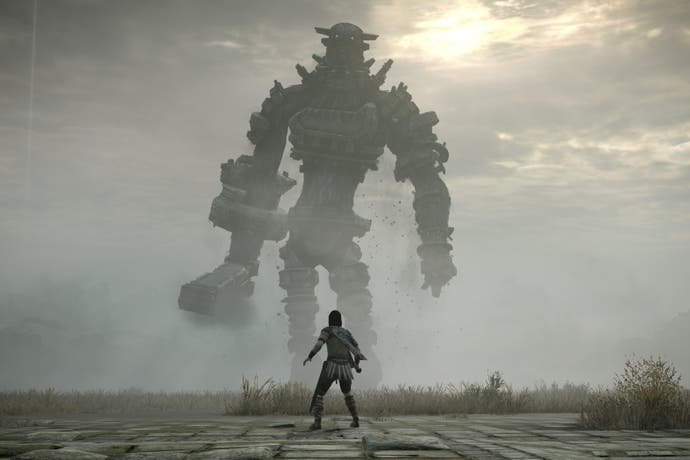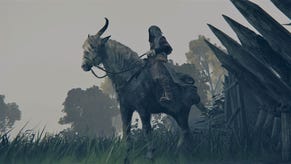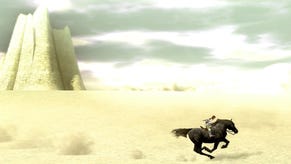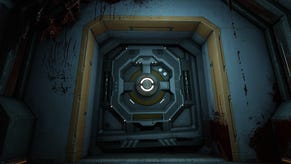Shadow of the Colossus PS4 review
Giant steps.
Shadow of the Colossus, like its predecessor Ico and successor The Last Guardian, is an artist's game. Its creative lead, Fumito Ueda, is an artist and animator with an instantly recognisable style: cracked stone, bleached sunlight, smoky shadows, frail limbs and pale, unfocused, unreadable faces. The three games are notable for their minimalist design, and they are no small feats of engineering, but it is the art that makes their worlds of innocence and ruin so indelible.
In the case of 2005's Shadow of the Colossus, it is the art that inspires awe and sorrow in equal measure as you explore a desolate landscape on a quest to slay 16 stone giants. The game is effectively little more than a boss rush, but it has a rare delicacy of mood as well as epic scale.
So this PlayStation 4 remake is a risky undertaking. The developer, Bluepoint Games of Austin, Texas, is the undisputed master of remasters and has even been here before, having made the Ico & Shadow of the Colossus Collection for PlayStation 3 in 2011. But this isn't a remaster. This is a remake, rebuilding the game from scratch using new technology and all-new, much more detailed art. Ueda wasn't involved and everything he and his team made for the original game has been redrawn and embellished to satisfy our hunger for fidelity. In a literal sense, this is an artist's game remade without the original artist and containing none of the original art. Could its spirit survive such a process?
Yes. And how. Bluepoint has achieved an unprecedented feat in game preservation that creates the definitive version of Shadow of the Colossus and makes a generations-old game feel excitingly modern.
You can read about its technical specification in detail in Digital Foundry's analysis by John Linneman, or watch his video which I've embedded here. In short: as well as the new art and stunning new lighting, you get a revised control scheme which is easier to use (the original controls are also available), a very welcome reduction in control lag, some optional, moody visual filters and a photo mode. You also get a beautifully engineered and smooth-running piece of software on both PS4 and PS4 Pro, far removed from the original game's chugging performance on PS2 - its grandest scenes having always been too much to ask of what, at the time, was an ageing console. On PS4, the game looks stunning and runs at a flawless 30 frames per second at 1080p. On Pro, you can choose between a Performance mode that boosts frame-rate to 60fps - again, pretty much flawless - or a Cinematic mode that kicks resolution up to 1440p for those with 4K TVs. Both look incredible.
It's just as important to note what Bluepoint's developers haven't changed, even though they might have been tempted to. The stubborn camera, for instance, which occasionally struggles to find the right angle and fights user input, always pushing back to its preferred position. It's far from perfect but it is an integral part of the game's character; leaving it to its own devices is often the best course. The same goes for our hero Wander's loose-limbed animation, which is very lifelike but uses lengthy routines that can be ungainly and unresponsive to control. This would have been a much harder fix - and it would have been even more wrong to undertake it. In fact, I'm not entirely sure it's not deliberate. All Ueda's player characters have a youthful, clumsy exuberance and a fragility that make for a striking contrast with the ancient, implacable masses that surround them.
It's on contrasts like this that the delicate power of Ueda's work rests, and this remake could easily have overwhelmed them with detail and spectacle. I'm amazed that it doesn't, because it has both detail and spectacle in spades: it draws deep into the distance where the original game dropped a discreet veil of fog, it adds fine texture to stone and fur and grass, it even physically animates the decorations on Wander's belt. It helps, perhaps, that Shadow of the Colossus is such an intentionally sparse game. All this filigree work has plenty of room to breathe amid its echoing ruins and silent, unpopulated plains. If pushed, you could argue that a little of the original's mystery has been lost by snapping the visuals into focus. I wouldn't go that far, and its grandeur has been amplified tenfold. The shadows of clouds track across rippling grasslands. Agro, Wander's steed, thunders across the map with a hefty, animal presence. Sandstorms diffuse the cooling light of this dying land to a sultry ochre. The colossi heave and crash, sending impact shockwaves before them.
It is an authentic labour of love, this release, and it improves Shadow of the Colossus in real ways. It runs better, it's easier to enjoy, it's more beautiful. It's bigger, which in this game really counts for something. But it's vital that Bluepoint has preserved the game itself absolutely unchanged, because Shadow of the Colossus has poetry and economy that you rarely find in games.
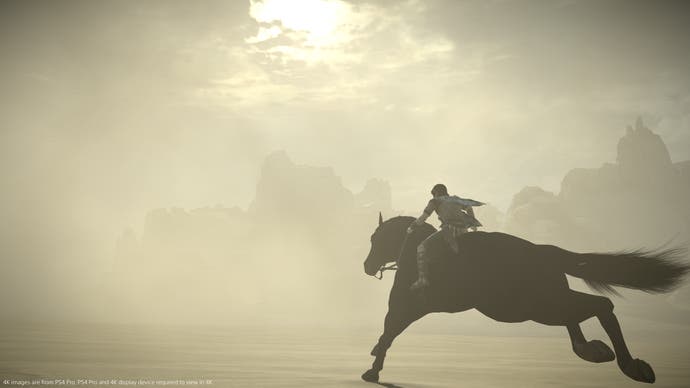
The storytelling is stark. It drinks from the deepest, darkest roots of fairy tales, and by doing away with any exposition until the final moments, it manages to get past centuries of tradition to draw on something raw and elemental beneath. A young man arrives in an empty, cursed land with the body of a young woman, who is either dead or in an eternal sleep. He has a legendary sword at his side. In a temple, a voice tells him that he may get what he seeks - to revive her, presumably, although we never truly find out - by finding and defeating sixteen great guardians.
So his quest begins, but although it sounds exactly like hundreds of other quests we have read or seen or played before, it is not quite like them. It discards context and character-building to the extent that we can't know that we are doing the right thing. The utter emptiness of the land is ominous, and gives space for doubts to seed and grow. In the absence of clear motivation, we push on, partly through curiosity and wonder, partly through a sense of inevitability - it feels like this has all been foretold - and partly through hubris, because conquering is what young men with swords at their side do.
The game has a simple rhythm. Wander and Agro surge across the land, following a beam of light reflected from his sword, to find the next colossus. There are sights to see, there's a little exploration to be done to find the right path, there are a handful of items that can be scavenged to restore health or improve stamina, but this time is mostly spent alone with the landscape. Then, the confrontation with the colossus. In many ways this is a typical boss fight: learn its behaviour, exploit it, find a weak spot to attack. The memorable twist is that these giants are more like great, moving buildings than enemies, and the puzzle is not how to dodge their attacks and retaliate, but how to manipulate their position until you can find purchase on them, scale them and find somewhere to drive your sword home.
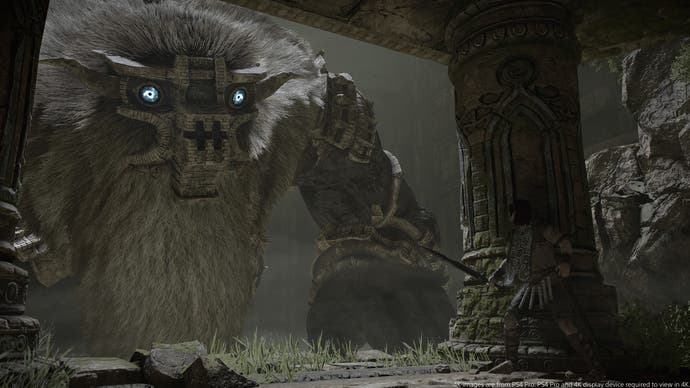
What makes these encounters unforgettable are the colossi themselves. They are majestic and scary, but there is something mournful about them too. They are made of a sort of muscled stone, covered in mossy fur and architectural crenellations, and they move with oceanic slowness. They seem ancient, and it's noticeable that not all of them are aggressive towards you at first. Sometimes the music that accompanies their appearance is stirring and martial, but sometimes it is wistful or eerie. The first, a lumbering ogre, starts with its back to you and must be brought to its knees. The third is a towering knight wielding a gigantic stone pillar like a sword; ascending him is a vertiginous experience. Several colossi resemble enormous wild beasts. The fifth, a great bird, swoops down at you and you must make a desperate leap to grab onto its wing and ride it into the air - a moment of heart-stopping immensity.
These are epic combats, staged to emphasise their dramatic scale. David and Goliath had nothing on Wander and the colossi. So why do you feel as much regret as triumph at the downing of a colossus? Because they're magnificent specimens, true wonders, and you don't want to see them die. Because even the angry ones don't seem like aggressors - it is you who disturbs their isolation, after all. When Wander drives his sword home, the animation has a painful, desperate brutality to it. Something black gushes out of the wound and the colossus roars in pain. When the colossus finally falls, Wander is assailed by streams of black shadow and passes out. It's not cathartic. It's pitiable.
The fights feel unfair in the opposite way that you would expect. The colossi are huge and Wander is small, yes, but they are slow and he is quick. They are old, so very old, and he is young. They represent timelessness and tradition, the earth, the gods, the great forces of the world. He represents man, and he doesn't care. He wants what he wants and he's going to take it.
Shadow of the Colossus is such a sad, beautiful, thrilling game. It's so bold in its austerity; compared to the frantic busywork of today's games, its sheer emptiness comes as a relief. So does its rejection of the triumphalism and moral certainty that underwrite virtually every other action game. It's a classic, and it's a privilege to play it in this stunning new form.
